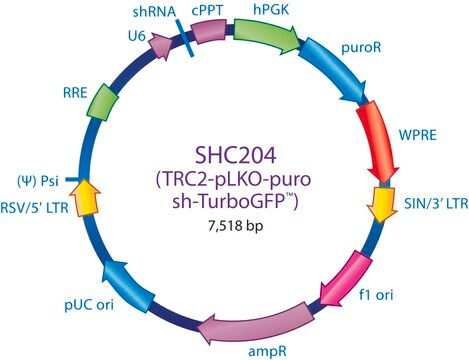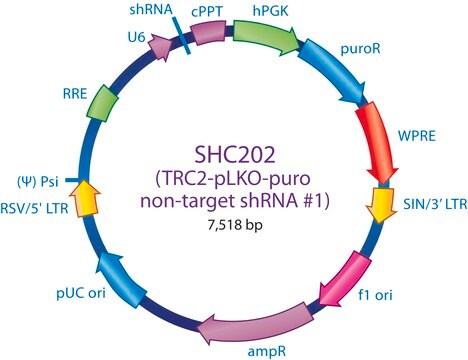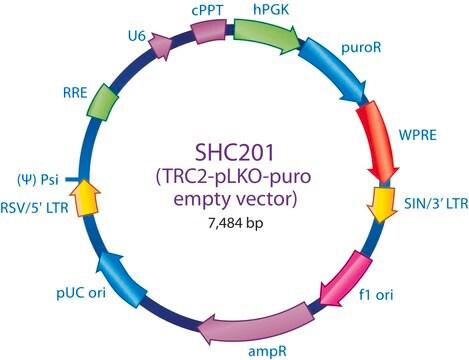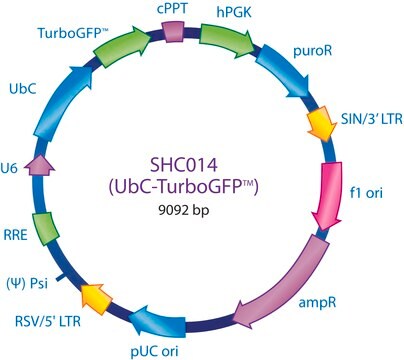SHC204
MISSION® TRC2 pLKO.5-puro TurboGFP™ shRNA Control Plasmid DNA
shRNA sequence targeting tGFP
Sinônimo(s):
MISSION® Control Vectors
Faça loginpara ver os preços organizacionais e de contrato
About This Item
Produtos recomendados
Nível de qualidade
linha de produto
MISSION®
concentração
500 ng/μL in TE buffer; DNA (10μg of plasmid DNA)
Condições de expedição
dry ice
temperatura de armazenamento
−20°C
Procurando produtos similares? Visita Guia de comparação de produtos
Categorias relacionadas
Descrição geral
The MISSION® TRC2 Control Vector pLKO-puro TurboGFP™ shRNA is a 7518 base pair lentivirus plasmid vector that contains an shRNA sequence targeting TurboGFP™. This vector is in the TRC2 pLKO-puro plasmid backbone, which contains the WPRE. The TurboGFP™ shRNA Control Vector is useful as a positive knockdown control in experiments using the MISSION® TurboGFP™ positive control vector in cell lines expressing TurboGFP™. TurboGFP™ is an improved variant of the green fluorescent protein copGFP cloned from copepoda Pontellina plumata.
Ampicillin and puromycin antibiotic resistance genes provide selection in bacterial or mammalian cells respectively. In addition, self-inactivating replication incompetent viral particles can be produced in packaging cells (HEK293T) by co-transfection with compatible packaging plasmids (SHP001). The TRC2 TurboGFP™ shRNA Control Vector is provided as 10 μg of plasmid DNA in Tris-EDTA (TE) buffer at a concentration of 500 ng/μl.
Ampicillin and puromycin antibiotic resistance genes provide selection in bacterial or mammalian cells respectively. In addition, self-inactivating replication incompetent viral particles can be produced in packaging cells (HEK293T) by co-transfection with compatible packaging plasmids (SHP001). The TRC2 TurboGFP™ shRNA Control Vector is provided as 10 μg of plasmid DNA in Tris-EDTA (TE) buffer at a concentration of 500 ng/μl.
Aplicação
Small interfering RNAs (siRNAs) expressed from short hairpin RNAs (shRNAs) are a powerful way to mediate gene specific RNA interference (RNAi) in mammalian cells. The MISSION product line is based on a viral vector-based RNAi library against annotated mouse and human genes. shRNAs that generate siRNAs intracellularly are expressed from amphotropic lentivirus viral particles, allowing screening in a wide range of mammalian cell lines. In these cell lines, MISSION shRNA clones permit rapid, cost efficient loss-of-function and genetic interaction screens.
To see more application data, protocols, vector maps visit sigma.com/shrna.
Informações legais
Use of this product is subject to one or more license agreements. For details, please see http://sigmaaldrich.com/missionlicense.
MISSION is a registered trademark of Merck KGaA, Darmstadt, Germany
TurboGFP is a trademark of Evrogen Co.
recomendado
Nº do produto
Descrição
Preços
Código de classe de armazenamento
12 - Non Combustible Liquids
Classe de risco de água (WGK)
WGK 3
Ponto de fulgor (°F)
Not applicable
Ponto de fulgor (°C)
Not applicable
Certificados de análise (COA)
Busque Certificados de análise (COA) digitando o Número do Lote do produto. Os números de lote e remessa podem ser encontrados no rótulo de um produto após a palavra “Lot” ou “Batch”.
Já possui este produto?
Encontre a documentação dos produtos que você adquiriu recentemente na biblioteca de documentos.
Os clientes também visualizaram
Restrictive influence of SAMHD1 on Hepatitis B Virus life cycle.
Sommer AF
Scientific Reports, 6, 26616-26616 (2016)
Miguel A Gonzalez-Lozano et al.
Scientific reports, 6, 35456-35456 (2016-10-18)
Development of the brain involves the formation and maturation of numerous synapses. This process requires prominent changes of the synaptic proteome and potentially involves thousands of different proteins at every synapse. To date the proteome analysis of synapse development has
Luisa Mori et al.
Journal of virology (2020-11-27)
HIV transcription requires assembly of cellular transcription factors at the HIV-1promoter. The TFIIH general transcription factor facilitates transcription initiation by opening the DNA strands around the transcription start site and phosphorylating the C-terminal domain for RNA polymerase II (RNAPII) for
J E Donello et al.
Journal of virology, 72(6), 5085-5092 (1998-05-30)
The hepatitis B virus posttranscriptional regulatory element (HBVPRE) is a cis-acting RNA element that partially overlaps with enhancer I and is required for the cytoplasmic accumulation of HBV surface RNAs. We find that the closely related woodchuck hepatitis virus (WHV)
R Zufferey et al.
Journal of virology, 73(4), 2886-2892 (1999-03-12)
The expression of genes delivered by retroviral vectors is often inefficient, a potential obstacle for their widespread use in human gene therapy. Here, we explored the possibility that the posttranscriptional regulatory element of woodchuck hepatitis virus (WPRE) might help resolve
Nossa equipe de cientistas tem experiência em todas as áreas de pesquisa, incluindo Life Sciences, ciência de materiais, síntese química, cromatografia, química analítica e muitas outras.
Entre em contato com a assistência técnica











